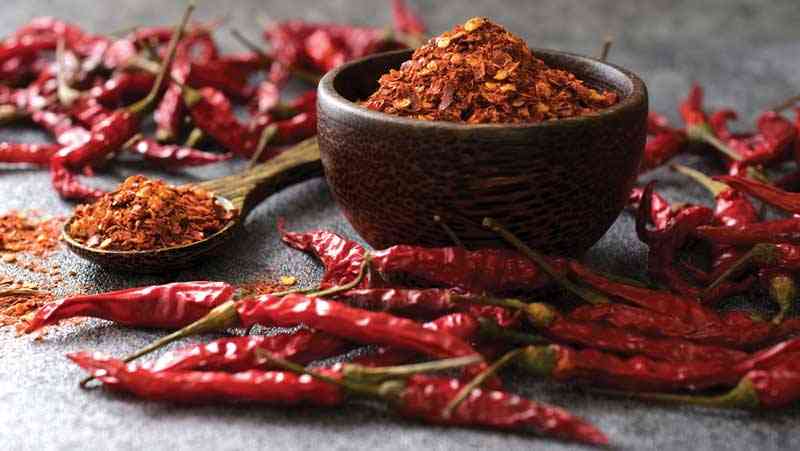
BY MTHANDAZO NYONI
THE popularity of international cuisine and spicy food have increased demand for dried chillies on the global market, ZimTrade has revealed.
Demand is projected to go up due to the consumers’ inclination towards organic and natural ingredients. This, according to ZimTrade, is opening up opportunities for local chilli producers.
The upward trend is also being driven by increasing demand for healthier food additives for making spice oils and natural colouring agents in Europe.
According to ZimTrade’s latest newsletter, the growing global demand for spices, coupled with dwindled supply from traditional source markets, presents an opportunity for local producers to increase exports of chilli to the world market.
The export promotion organisation, said the climatic conditions in Zimbabwe are favourable for sustained chilli production.
“Given the suitable and large land area available for production, Zimbabwean farmers have capacity to produce enough supplies that will increase the country’s share of the global market,” the organisation said.
Chilli is the fruit of plants from the genus Capsicum, a member of the nightshade family, Solanaceae.
- Zimbabwe’s trade deficit narrows to US$179m
- Zimbabwe’s trade deficit narrows to US$179m
- Malawi warms up to Zim products
- ZimTrade targets African markets
Keep Reading
They could be green, yellow, orange, red or black. There are more than 200 known varieties and they differ greatly in size, colour, and level of hotness.
The bird’s eye chilli is the most common variety that is exportable. Its greatest advantage is that it could be sold fresh from the farm or dried.
It can be grown in open fields, greenhouses, under shade nets, pot, containers and even in back yards.
In terms of what sells better, ZimTrade said fresh chillies that are organically grown in Zimbabwe are competitive on the export market because more people are increasingly paying attention to healthy eating.
“Zimbabwean farmers can improve their competitiveness and achieve the required volumes by developing active produce consolidation models,” it said.
“This allows smallholder farmer, whose capacity is small, to combine produces and contribute enough export figures."
According to Market Access, the price of chilli in the global market between July and August 2022 has reached a high of US$18,17 per kg with the average price being US$6,58 per kg.
The Netherlands is paying the highest price for chilli at US$18,17 per kg, while South Africa has the lowest price at US$0,68
ZimTrade said chillies require a relatively low budget of about US$600 per hectare, if done in good time.
“Farmers may choose not to use fertilisers and go organic, and this helps cut on costs. One of the advantages of chillies is that farmers can buy seeds and do a nursery on their own,” it said.
“Even though chillies are a summer crop, the seedlings fare well during the winter season.”
According to the Trade Map, in 2021, imports reached 1,9 million tonnes and the total imported value was US$3,7 billion, consumption is estimated to have been around 20 000 tonnes. The Trade Map figures showed that the United Kingdom was the second-largest importer of dried chillies in Europe. In 2021, the UK imported 417 000 tonnes of chillies worth US$1 billion. Consumption was estimated at around 15 000 tonnes. The Netherlands is also an important importer of dried chillies. Trade Map notes that Netherlands, in 2021, imported 121 000 tonnes of chillies, worth around US$231 million.
ZimTrade said the Netherlands is an important trade hub in Europe as around 45% of all imported dried chillies are re-exported to other markets in Europe, Middle-East and beyond. According to the Centre for the Promotion of Imports from developing countries (CBI), Europe was the world's second-largest importer of dried chillies , after Asia, but ahead of the USA, accounting for around 40% share of total world’s imports.
European imports of dried chillies increased every year in volume in the period between 2017 and 2021.
“Around two-thirds of European imports come from developing countries. Also, the largest share of the intra-European trade consists of re-exports of dried chillies that originally came from Africa," the organisation said.
The CBI said European markets offer a price advantage over Asian markets for high-quality and sustainably produced dried chilli exporters.
To illustrate, during 2021, the average unit value of imported whole dried chillies in most of the Asian markets was around US$2 per kg, while in Germany and France, the average import values were US$3,3 per kg and US$4,9 per kg, respectively. ZimTrade said the European market for fresh chilli peppers was a specialised market, which was supplied primarily by producers in southern Europe, Morocco and Turkey. Due to the strong regional competition, most opportunities are in the off-season and growing specific chilli pepper varieties, ZimTrade said











